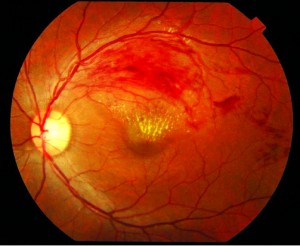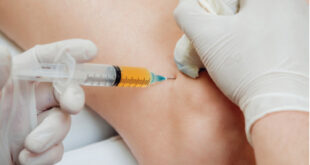By Lauren R. Rosecan, M.D., Ph.D., F.A.C.S.
 Arteries and veins carry blood throughout your body, including your eyes. The eye’s retina has one main artery and one main vein. When branches of the retinal vein become blocked, it is called branch retinal vein occlusion (BRVO).
Arteries and veins carry blood throughout your body, including your eyes. The eye’s retina has one main artery and one main vein. When branches of the retinal vein become blocked, it is called branch retinal vein occlusion (BRVO).
When the vein is blocked, blood and fluid spills out into the retina. The macula can swell from this fluid, affecting your central vision. Eventually, without blood circulation, nerve cells in the eye can die and you can lose more vision.
BRVO Symptoms
The most common symptom of branch retinal vein occlusion (BRVO) is vision loss or blurry vision in part or all of one eye. It can happen suddenly or become worse over several hours or days. Sometimes, you can lose all vision suddenly.
You may notice floaters. These are dark spots, lines or squiggles in your vision. These are shadows from tiny clumps of blood leaking into the vitreous from retinal vessels.
Who Is At Risk for Branch Retinal Vein Occlusion (BRVO)?
BRVO usually happens in people who are aged 50 and older.
People who have the following health problems have a greater risk of BRVO:
– High blood pressure
– Diabetes;
– glaucoma and hardening of the arteries
(called arteriosclerosis)
To lower your risk for BRVO, you should do the following:
eat a low-fat diet, get regular exercise, maintain an ideal weight and don’t smoke.
Your ophthalmologist will widen (dilate) your pupils with eye drops and check your retina.
They may do a test called fluorescein angiography. Yellow dye (called fluorescein) is injected into a vein, usually in your arm. The dye travels through your blood vessels. A special camera takes photos of your retina as the dye travels throughout the vessels. This test shows if any retinal blood vessels are blocked.
Also, your blood sugar and cholesterol levels may be tested.
People under the age of 40 with branch retinal vein occlusion (BRVO) may be tested to look for a problem with their blood clotting or thickening.
BRVO Treatment
Branch retinal vein occlusion (BRVO) cannot be cured. The main goal of treatment is to keep your vision stable. This is usually done by sealing off any leaking blood vessels in the retina. This helps prevent further swelling of the macula.
Your ophthalmologist may do a form of laser surgery called MicroPulse focal laser treatment. A laser is used to make tiny burns to areas around the macula but it leaves no scar. This helps stop fluid from leaking from the vessels.
Your ophthalmologist may also choose to treat your BRVO with medication injections in the eye. The medicine can help reduce the swelling of the macula. These injections are a type of medicine called “anti-VEGF.” They can improve vision in about 1 of 2 patients who take them. Injections need to be given regularly for one to two years for the benefit to last.
It usually takes a few months before you notice your vision improving after treatment. While most people see some improvement in their vision, some people won’t have any improvement.
For those who don’t show improvement with anti-VEGF, steroid injections or steroid implants may be an option. The steroid implant can improve vision in close to a third of people with BRVO.
Lauren R. Rosecan
M.D., Ph.D., F.A.C.S.
The Retina Institute of Florida with four offices
conveniently located in Palm Beach and Martin Counties.
Toll Free Phone Number:
1-800-445-8898 561-832-4411
West Palm Beach
901 North Flagler Drive, 33401.
(561) 832-4411 Office. (561) 832-1591 Fax
Palm Beach Gardens
11382 Prosperity Farms Rd., #128, 33410.
(561) 627-7311 Office. (561) 627-6791 Fax
Stuart
618 East Ocean Blvd., #3, 34994.
(772) 287-7026 Office. (772) 220-4186 Fax
Boca Raton
1050 NW 15th Street, #114, 33486.
(561) 368-7723 Office. (561) 368-0093 Fax
 South Florida Health and Wellness Magazine Health and Wellness Articles
South Florida Health and Wellness Magazine Health and Wellness Articles




